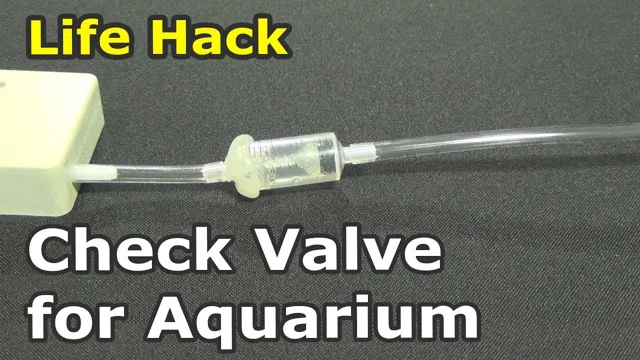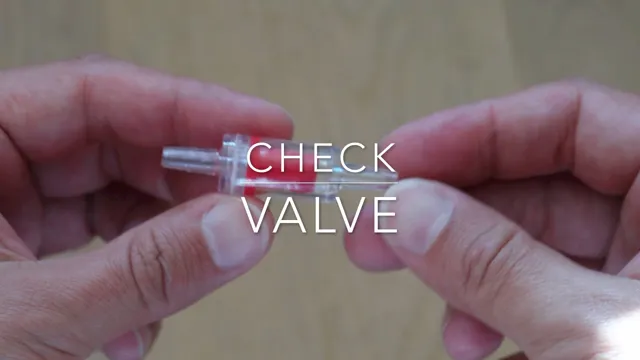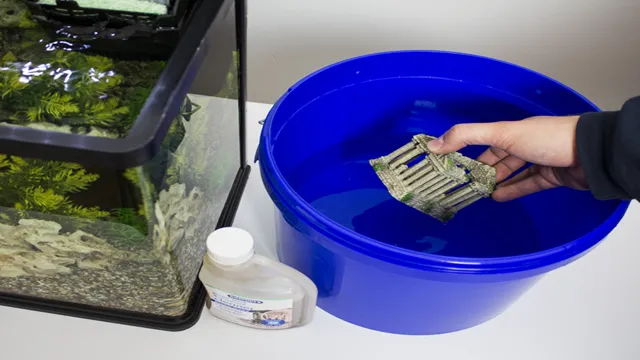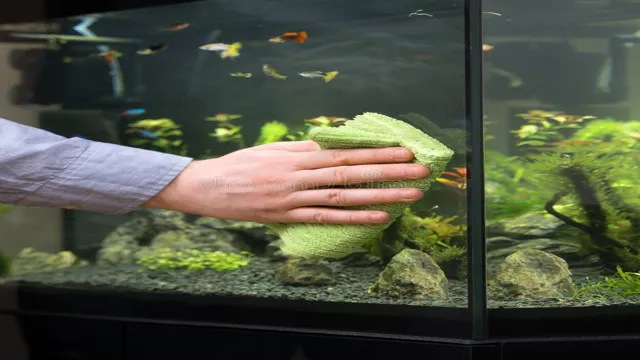How to Install Aquarium Check Valve: A Step-by-Step Guide for Beginners

Do you want to make sure your aquarium remains fully functional without any hindrances? One way to do that is by installing an aquarium check valve. This small but essential component plays a crucial role in maintaining the right water level in your tank. It prevents water from flowing backward and damaging the pump and filter.
It also ensures that the fish and plants in your tank get the right amount of oxygen by regulating the air supply. Without a check valve, you run the risk of water damage, harm to your aquatic life, and expensive repairs. In this blog, we will guide you through the ins and outs of installing an aquarium check valve, so you can keep your tank running smoothly and safely.
What is a Check Valve?
If you have an aquarium, you might have heard of a check valve. A check valve is a small device that allows water to flow in only one direction. This is an essential tool to prevent backflow in your aquarium, which can lead to water spills and other potential hazards.
Installing a check valve is relatively easy, and you only need a few tools and materials, such as tubing and clamps. First, remove the tubing from the pump and cut it to the desired length. Then, insert one end of the tubing into the check valve and secure it with a clamp.
Finally, attach the other end to your device and secure it with another clamp. Remember that the check valve should always be installed above the waterline to maximize its efficiency. With a check valve, you can rest assured that your aquarium will remain safe and sound from any water damage.
Definition of a Check Valve
A check valve is a type of valve used to control the flow of fluid in a pipeline system. It is also known as a non-return valve or one-way valve because it allows fluid to flow in only one direction. The valve has a disc or a ball that opens or closes the valve depending on the direction of the flow.
It is commonly used in irrigation systems, water treatment plants, and industrial applications to prevent backflow or reverse flow of the fluid, which can damage the system or contaminate the fluid. The check valve ensures that the fluid flows in the intended direction and does not flow back into the source. So, if you require a valve that allows fluid flow in one direction only, a check valve is the perfect solution for your system.

Reasons for Installing a Check Valve
A check valve is an essential component of any piping system that allows the flow of fluid in one direction only while preventing backflow. It works by opening and closing a moving part, typically a flap or gate, in response to changes in pressure. The valve closes automatically when the pressure drops, preventing any reverse flow and thus protecting the system.
Check valves are used in a variety of applications where backflow could pose a problem, such as in wastewater treatment plants, oil and gas pipelines, and even in household plumbing systems. Installing a check valve can help to avoid costly and potentially dangerous situations caused by backflow, such as contaminated water or burst pipes. It can also improve the overall efficiency of a system by reducing the risk of fluid loss or damage to equipment.
In short, incorporating a check valve into your piping system is a simple but effective way to ensure the safety and reliability of your system.
Choosing the Right Check Valve
Installing an aquarium check valve is an essential step in ensuring the safety and longevity of your aquatic pets. But with so many options out there, it can be challenging to choose the right one. Start by determining the flow rate of your aquarium pump and the diameter of the tubing.
This information will help you select a check valve that can handle the appropriate volume of water and fit your tubing snugly. It’s also important to consider the material of the check valve. PVC is a common choice for aquariums due to its durability and resistance to corrosion.
Lastly, make sure to properly install the check valve in the correct direction, with the arrow pointing in the direction of water flow. A properly functioning aquarium check valve can prevent water from backflowing into your pump and causing damage, which can save you time and money in the long run.
Type of Valve Needed for Aquarium
When it comes to choosing the right valve for your aquarium, a check valve is a must-have component. A check valve prevents water from backflowing into your aquarium, which can cause harm to your fish and other aquatic animals. But with so many options available, how do you know which one is the right fit for your aquarium? Firstly, consider the material of the valve.
PVC and silicone check valves are commonly used in aquariums and are resistant to corrosion and chemicals. Secondly, think about your aquarium’s water flow rate and choose a valve that can handle that rate. Lastly, choose a valve that is easy to install and maintain, so you don’t have to worry about frequent replacements or cleaning.
By taking these factors into account, you can ensure that you choose the right check valve for your aquarium, providing a safe and healthy environment for your aquatic pets.
Factors to Consider When Choosing a Valve
When it comes to choosing the right check valve, there are a few key factors to consider. The first and most important is the type of pressure and flow rate your system requires. Different types of check valves are designed to handle different levels of pressure and flow, so it’s important to choose one that can keep up with your system’s demands.
Another important consideration is the type of fluid you’ll be working with. Some check valves are better suited for handling corrosive or abrasive fluids, while others are designed to work with more standard liquids. Finally, you’ll want to think about the level of maintenance and durability you need in your valve.
Some valves require more maintenance than others, so be sure to choose one that fits your needs. Overall, taking the time to carefully evaluate your system’s requirements and choose the right valve can help ensure smooth and reliable operations.
Installation Steps for Aquarium Check Valve
If you want to ensure that your aquarium stays in top condition, it’s important to install an aquarium check valve properly. This is a device that helps to prevent water from flowing back into the air pump, which can cause damage to the pump or even cause it to fail. The first step is to make sure that you have the right type of check valve for your aquarium setup.
Once you have that, you will need to install it in the right location, which is usually between the air pump and the tubing that connects to the air stone or other accessories. To do this, you will need to attach the check valve to the tubing using the supplied connectors, making sure that you have a good seal. Once you have everything connected, check to make sure that there are no leaks and that the air is flowing properly.
With a properly installed check valve, you can rest assured that your aquarium will stay safe and healthy for your aquatic pets.
Gather Required Tools
If you’re a proud aquarium owner, you already know how important it is to keep your fish and plants healthy. One of the essential tools every aquarium owner should have is a check valve. It helps to prevent backflow of water from the aquarium, which could cause damage to your equipment and even harm your aquatic life.
Before you start installing your new check valve, you’ll need a few tools. These include thread seal tape, scissors, a utility knife, a Phillips head screwdriver, and the check valve itself. Once you’ve collected all the necessary tools, it’s time to move on to the installation process.
Determine Placement for Valve
When installing an aquarium check valve, it’s essential to determine the placement of the valve to ensure that it functions correctly. The valve needs to be installed in a spot where it can prevent water from flowing back into the air pump, which can cause damage to the pump and create a safety hazard for your fish. A good place to install the valve is near the bottom of the aquarium, close to the air pump.
This placement ensures that any water that enters the valve gets trapped, preventing it from flowing back into the air pump. It’s also essential to ensure that the valve is correctly oriented, with the arrow on the valve pointing towards the air pump. Once the valve is installed correctly, install the airline tubing, attach the valve to the tubing, and secure it in place using clamps or suction cups.
By following these few simple steps, you can prevent backflow and keep your aquarium functioning smoothly.
Attach Valve to Airline Tubing
An aquarium check valve is a necessary item that every fish tank owner must have. It helps to regulate the air flow in the aquarium, preventing back-flow and protecting the pump from water damage. Installing a check valve is quite easy to do, and can be done in a few simple steps.
First, cut the airline tubing to the desired length and attach it to the pump or air stone. Then, insert one end of the check valve into the tube, and the other end into another section of tubing. This will ensure that no water will enter the pump if there is a sudden power outage or if the pump fails.
Finally, attach the valve to the tubing, making sure it is secure and airtight. By following these simple steps, you can ensure that your aquarium runs smoothly, and your fish stay happy and healthy. Remember, investing in a check valve is a small price to pay for the peace of mind it will provide.
Test for Proper Functioning
If you own an aquarium, an essential accessory to keep it running smoothly is a check valve. A check valve helps maintain proper functioning by ensuring water flows in one direction only, preventing backflow. Installing a check valve is a simple process that can be done in six easy steps.
First, ensure you have all the necessary tools and components such as a check valve and tubing. Next, turn off all equipment to prevent any accidental damage during installation. Third, cut a length of tubing and attach it to the check valve inlets.
Fourth, attach the other end of the tubing to the equipment outlet. Fifth, secure all connections with hose clamps. Lastly, turn on all equipment and check the valve for proper functioning.
A properly installed check valve will protect your aquarium equipment from any damage that may result from backflow, ensuring your aquarium operates smoothly.
Maintenance Tips for Your Check Valve
If you own an aquarium, you know how important it is to maintain it to keep your fish healthy and happy. One crucial component of your aquarium system is the check valve. A check valve prevents backflow of water from your aquarium, essentially ensuring that water flows in one direction only.
Installing a check valve is fairly straightforward, although it’s important to ensure that you have the right size and type for your system. When installing, make sure to install it vertical for it to function properly. Additionally, it’s important to regularly maintain your check valve by cleaning it and ensuring that it’s free of any debris.
This will help prolong the life of your check valve and prevent any potential issues with backflow. By following these simple maintenance tips, you’ll be able to keep your aquarium running smoothly and your fish happy.
Regular Cleaning and Inspection Recommended
Regular cleaning and inspection are crucial for the proper functioning of check valves. It is because the check valve’s primary function is to allow fluid to flow in one direction and prevent backflow, which can cause damage to other components in the system. Regular cleaning can help prevent build-up of debris, dirt, and sediment that can impair the valve’s performance or cause failure.
It is also essential to check for any signs of wear and tear, including leaks, corrosion, and cracks, during these inspections. Addressing these issues immediately can prevent more significant problems in the future. It is recommended to follow the manufacturer’s guidelines when cleaning and inspecting your valve to ensure optimal performance and longevity.
Regular maintenance of your check valve can save you time and money in the long run by avoiding costly repairs and replacement of the valve. So, be proactive and schedule regular cleaning and inspection to keep your check valve working at its best.
Replacing Old or Malfunctioning Valves
If you want to ensure that your valves perform efficiently, regular check valve maintenance is a must. It’s important to keep an eye on your valves and replace any old or malfunctioning valves as soon as possible. A malfunctioning valve can lead to problems such as decreased efficiency, leaks, or even system failure.
One tip is to periodically check the valve body and connection points to make sure there are no signs of wear or corrosion. You should also check the valve seal for signs of wear and replace it if necessary. By performing these simple maintenance tasks, you can extend the life of your valves and prevent costly downtime.
Remember, investing in regular maintenance now can save you a lot of trouble down the line.
Conclusion
In conclusion, installing an aquarium check valve is like giving your fish a safety net – it ensures a stable and secure environment for them to thrive in. With just a few simple steps, you can easily install a check valve and protect your aquatic friends from potential disaster. Just remember to take your time, double-check your connections, and don’t be afraid to ask for help if you need it.
Trust us, your fish will thank you for the peace of mind!”
FAQs
What is an aquarium check valve and why is it important?
An aquarium check valve is a device that prevents water from flowing back into the air pump or CO2 regulator. It is important to use this valve to avoid damage to your equipment.
How do I install an aquarium check valve?
To install an aquarium check valve, simply cut the tubing and insert each end into the valve. Make sure to tighten the connections and check for leaks.
Can I use a check valve with both air and CO2 equipment?
Yes, you can use a check valve with both air and CO2 equipment. However, make sure to use separate valves for each type of equipment.
How often should I replace my aquarium check valve?
It is recommended to replace your aquarium check valve every 6 to 12 months, depending on usage and wear.
How do I clean my aquarium check valve?
To clean your aquarium check valve, simply remove it from the tubing and soak it in a solution of water and vinegar for 30 minutes. Rinse thoroughly and let dry before re-installing.
Can a faulty check valve harm my fish?
Yes, a faulty check valve can harm your fish by allowing water to flow back into the air pump or CO2 regulator, potentially damaging the equipment and causing stress to your fish.
Are there different types of aquarium check valves?
Yes, there are different types of aquarium check valves, including in-line valves, compact valves, and bellows valves. Choose the type that best suits your aquarium setup and equipment.






